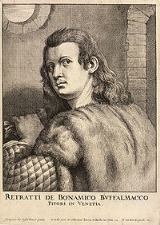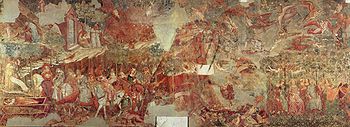
Buonamico Buffalmacco
Encyclopedia
.jpg)

Florence
Florence is the capital city of the Italian region of Tuscany and of the province of Florence. It is the most populous city in Tuscany, with approximately 370,000 inhabitants, expanding to over 1.5 million in the metropolitan area....
, Bologna
Bologna
Bologna is the capital city of Emilia-Romagna, in the Po Valley of Northern Italy. The city lies between the Po River and the Apennine Mountains, more specifically, between the Reno River and the Savena River. Bologna is a lively and cosmopolitan Italian college city, with spectacular history,...
and Pisa
Pisa
Pisa is a city in Tuscany, Central Italy, on the right bank of the mouth of the River Arno on the Tyrrhenian Sea. It is the capital city of the Province of Pisa...
. Although none of his known work has survived, he is widely assumed to be the painter of a most influential fresco
Fresco
Fresco is any of several related mural painting types, executed on plaster on walls or ceilings. The word fresco comes from the Greek word affresca which derives from the Latin word for "fresh". Frescoes first developed in the ancient world and continued to be popular through the Renaissance...
cycle in the Camposanto in Pisa, featuring the The Three Dead and the Three Living, the Triumph of Death, the Last Judgement, the Hell, and the Thebais (several episodes from the lives of the Holy Fathers in the Desert). Painted some ten years before the Black Death spread over Europe in 1348, the cycle - a "painted sermon" (L. Bolzoni) - enjoyed an extraordinary success after that date, and was often imitated throughout Italy. The youngsters' party enjoying themselves in a beautiful garden while Death piles mounds of corpses all around is likely to have inspired the setting of Giovanni Boccaccio's Decameron, written a few years after the Black Death.
Boccaccio
Giovanni Boccaccio
Giovanni Boccaccio was an Italian author and poet, a friend, student, and correspondent of Petrarch, an important Renaissance humanist and the author of a number of notable works including the Decameron, On Famous Women, and his poetry in the Italian vernacular...
(in his Decameron
The Decameron
The Decameron, also called Prince Galehaut is a 14th-century medieval allegory by Giovanni Boccaccio, told as a frame story encompassing 100 tales by ten young people....
) and Franco Sacchetti
Franco Sacchetti
Franco Sacchetti , was an Italian poet and novelist.-Biography:Born in Florence or in Ragusa , he was the son of Benci di Uguccione, surnamed "Buono", Florentine merchant of the noble and ancient family of the Sacchetti...
(in his Il trecentonovelle) both describe Buonamico as being a practical joker. Boccaccio features Buonamico along with his friends and fellow painters Calandrino
Calandrino
Calandrino is a beloved character from Giovanni Boccaccio's the Decameron, in which he appears as a character in four stories. In these tales he is the victim of the pranks of Bruno and Buffalmacco....
and Bruno in several tales (Day VIII, tales 3, 6, and 9; Day IX, tales 3 and 5)
Summary of Decameron tales
This article contains summaries and commentaries of the 100 stories contained in Giovanni Boccaccio's The Decameron.Each story of the Decameron begins with a short heading explaining the plot of the story. The 1903 J. M. Rigg English translation headings are used in many of these summaries...
. Typically in these stories, Buonamico uses his wits to play tricks on his friends and associates: convincing Calandrino that a stone he possesses (heliotrope
Heliotrope
Heliotrope may refer to:Natural science* Heliotropium, a genus of flowering plants* A plant that exhibits heliotropism, diurnal motion in response to the sun's movement* Heliotrope Media and entertainment...
) confers invisibility (VIII/3), stealing a pig from Calandrino (VIII, 6), convincing the physician Master Simone of an opportunity to ally himself with the devil (VIII, 9), convincing Calandrino that he has become pregnant (IX, 3), convincing Calandrino that a particular scroll can cause a woman to fall in love with him (IX, 5). Throughout the stories, Buonamico is frequently depicted at work painting in the houses of notable gentlemen in Florence but eager to take time to eat, drink and be merry.
Giorgio Vasari
Giorgio Vasari
Giorgio Vasari was an Italian painter, writer, historian, and architect, who is famous today for his biographies of Italian artists, considered the ideological foundation of art-historical writing.-Biography:...
includes a biography of Buonamico in his Lives
Lives of the Most Excellent Painters, Sculptors, and Architects
The Lives of the Most Excellent Italian Painters, Sculptors, and Architects, from Cimabue to Our Times, or Le Vite de' più eccellenti pittori, scultori, e architettori da Cimabue insino a' tempi nostri, as it was originally known in Italian, is a series of artist biographies written by 16th century...
, in which he tells several anecdotes about his comic escapades. Vasari tells of Buonamico's youthful tricking of his master Tafi during his apprenticeship, various pranks and tricks that Buonamico played on his patrons, and his habit of embedding texts within his paintings. Dismissed by Vasari as just another of the witty painter's gags, which his "clumsy" contemporaries had misunderstood and foolishly imitated, the Camposanto frescoes are actually scattered with texts, a possible indication of the veracity of Vasari's remark. In the scroll over the cripple beggars in the center of The Triumph of Death, for instance, it says, "Since prosperity has completely deserted us, O Death, you who are the medicine for all pain, come to give us our last supper."
Vasari discusses various paintings by the artist which no longer exist, and many of which had already perished by the time of Vasari's writing in the sixteenth century. He describes a series of paintings at the convent of Faenza in Florence (already destroyed by the sixteenth century), works for the abbey of Settimo (now also lost), tempera paintings for the monks of the abbey of Certosa (also in Florence), and frescoes in the Badia at Florence. He describes a series of paintings depicting the life of Saint Catherine of Siena in a chapel in her honor in Assisi at the Basilica of Saint Francis
Basilica of San Francesco d'Assisi
The Papal Basilica of St. Francis of Assisi is the mother church of the Roman Catholic Order of Friars Minor—commonly known as the Franciscan Order—in Assisi, Italy, the city where St. Francis was born and died. The basilica is one of the most important places of Christian pilgrimage in Italy...
(an attribution rejected by later scholars), and several prominent commissions at various abbeys and convents in Pisa
Pisa
Pisa is a city in Tuscany, Central Italy, on the right bank of the mouth of the River Arno on the Tyrrhenian Sea. It is the capital city of the Province of Pisa...
. Interestingly, Vasari does not attribute the famed Pisan frescoes now associated with Buonamico to the painter, but rather, credits him with four frescoes at the Camposanto depicting the beginning of the world through the building of Noah's Ark, which later scholars have instead attributed to Piero di Puccio
Piero di Puccio
Piero di Puccio was a fourteenth century Italian painter of the Gothic period, active mainly in Orvieto. He is also known as Pietro di Puccio. He painted a fresco of stories from Genesis, from the Creation to the Deluge on the North wall of Campo Santo in Pisa. The fresco was devastated during the...
of Orvieto.
Vasari presents conflicting information regarding Buonamico's death, dating it to the year 1340, but also stating that he was still alive in 1351. In any case, he is said to have died at the age of 78, in poverty, and to have been buried at the hospital of Santa Maria Novella, in Florence
Florence
Florence is the capital city of the Italian region of Tuscany and of the province of Florence. It is the most populous city in Tuscany, with approximately 370,000 inhabitants, expanding to over 1.5 million in the metropolitan area....
.
External links
See also
- CalandrinoCalandrinoCalandrino is a beloved character from Giovanni Boccaccio's the Decameron, in which he appears as a character in four stories. In these tales he is the victim of the pranks of Bruno and Buffalmacco....

